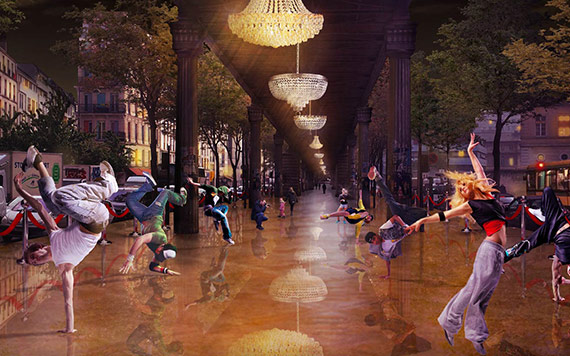
first prize!
Rethinking an unused viaduct in Hammersmith/London. greenhouses cultivate vegetables along the top of the rails, while fish are bred in aquariums below the arches, creating an aquaponic metabolic circle. Locals can participate in the food production and benefit from the infrastructure in leisure activities such as swimming and fishing. Urban gardening incorporated into open green space and cultural events will soon be daily life amidst the urban hustle of London.
“So ambitious! Great to see a swimming area and sustainable water collection”
“Love the ambition”
the competition jury
The approximately 350-meter-long section of an disused railroad track in the London borough of Hammersmith presented itself in several respects as an opportunity for the repurposing infrastructure to create a local green space and neighborhood meeting place. London has recently declared itself the first National Park City, which, with the help of the city's residents, should be transformed into a green and livable city not only for its population, but also to provide a habitat for a rich variety of wildlife. To achieve this goal, abandoned sites in particular lend themselves to being reclaimed and transformed into a green space for all. Hammersmith would like to create a new attraction, the Highline, which has the potential to attract tourists to the district, as well as provide a place for the local community to interact with each other. One of the design goals was therefore to provide the Hammersmith Highline with a unique selling point that would focus on its ecological and socio-political objectives. If the Parisian Promenade Plantée stands for the green occupation of open spaces in the 1990s, and the New York High Line set the tone as a design statement with cultural added value at the beginning of the new millennium, the London Highline is to be an ecological statement with sociological significance for inner-city infrastructure reuse. The task was therefore met with a response that was both ecological and participatory. By means of aquaponics, fruits and vegetables are grown in greenhouses and form an ecological metabolism with the fish farms below. Fish tanks are added to the former railroad arches, utilizing the space in a visually attractive way, while the track area is occupied by greenery. The neighborhood can actively participate in the project by getting involved in urban agriculture, or by using the infrastructure for swimming or fishing. Cultural events are also to take place regularly in the newly created meeting place and become Hammersmith's blue-green living room and an attraction for tourists.
client: Hammersmith BID (Business Improvement District)
size: 0,3 ha
project stages: competition entry
award: 1st prize
external links: archdaily
related projects:



